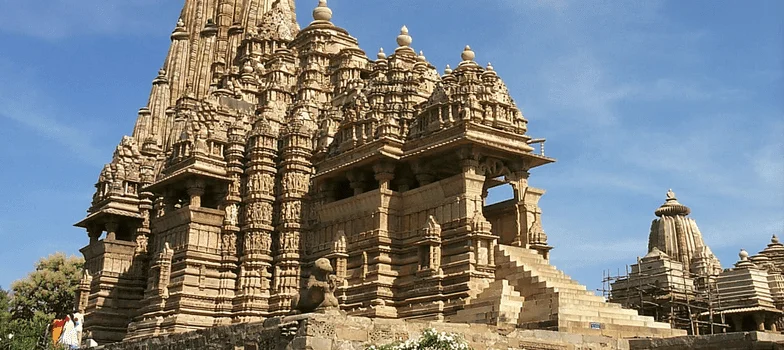As you step onto the ancient grounds of Khajuraho, a sense of wonder envelops you. The intricate carvings on the temples whisper tales of a bygone era, enticing you to unravel the mysteries hidden within each stone. But beyond the surface lies a deeper narrative waiting to be uncovered, one that transcends mere architectural beauty. Join us on a journey through time and artistry, where every sculpture holds a secret and every corner echoes with the whispers of history.
History of Khajuraho Temples
Located in the state of Madhya Pradesh, the history of Khajuraho Temples dates back to the 10th century. These temples were built by the Chandela dynasty, a powerful Rajput clan that ruled over this region during that time. The Chandela rulers were known for their love of art, architecture, and religious tolerance, which is evident in the exquisite temples they constructed.
The Khajuraho Temples were primarily dedicated to various Hindu deities like Vishnu, Shiva, and Devi. However, some temples also showcased Jain themes, reflecting the religious diversity prevalent during that era.
The intricate carvings adorning the temples depict various facets of life, including gods, goddesses, mythical creatures, and everyday activities. These sculptures aren’t just artistic marvels but also serve as a window into the society, culture, and beliefs of that period.
Over the centuries, the Khajuraho Temples have stood as a testament to India’s rich cultural heritage, attracting visitors from around the world to marvel at their beauty and historical significance.
Architectural Marvels of Chandela Dynasty
Marvel at the architectural splendors crafted by the Chandela dynasty, showcasing their unparalleled skill and creativity in temple construction. The temples of Khajuraho stand as a testament to the Chandela rulers’ mastery in architecture. These magnificent structures, built between 950 and 1050 AD, are renowned for their intricate carvings, exquisite sculptures, and elaborate designs.
The temples are divided into three groups – Western, Eastern, and Southern – each offering a unique architectural style and design. The Western group, including the Kandariya Mahadev Temple and Lakshmana Temple, is a prime example of the Chandela dynasty’s architectural brilliance.
The intricate detailing on the outer walls, depicting various deities, celestial beings, and daily life scenes, illustrates the craftsmanship and attention to detail of the Chandela artisans. The grandeur of these temples, with their towering spires and ornate carvings, transports visitors back in time to an era of unparalleled architectural excellence.
Marvel at the Chandela dynasty’s architectural legacy as you explore the temples of Khajuraho.
Significance of Erotic Sculptures
The erotic sculptures found in the temples of Khajuraho are a subject of intrigue and fascination for visitors. These intricate carvings are not merely about sensuality but also hold deeper cultural and religious significance. In Hinduism, the depiction of eroticism is considered a celebration of human life, love, and fertility, reflecting the belief that physical desires are a natural part of human existence.
To provide you with a glimpse of the diverse sculptures at Khajuraho, here is an engaging table showcasing the themes depicted in these remarkable artworks:
| Theme | Description |
|---|---|
| Mithuna | Embrace of a male and female in intimate poses |
| Yakshis | Female nature spirits symbolizing fertility |
| Kama Sutra Poses | Illustrations of various lovemaking positions |
Exploring these sculptures not only offers a unique perspective on ancient Indian art but also invites contemplation on the intersection of spirituality and human emotions.
Cultural Insights and Traditions
Amidst the intricate carvings and architectural splendor of Khajuraho’s temples, visitors are immersed in a rich tapestry of cultural insights and traditions.
- Vibrant Festivals: Experience the vibrant celebrations of festivals like Mahashivratri and Khajuraho Dance Festival, where the air is filled with the sounds of traditional music and the sight of colorful performances that showcase the region’s artistic heritage.
- Spiritual Practices: Witness the deep-rooted spiritual practices of the locals as they participate in rituals and ceremonies that have been passed down through generations, offering a glimpse into the profound connection between the community and its ancient traditions.
- Artistic Expressions: Marvel at the artistic expressions found not only in the temples’ sculptures but also in the local handicrafts and dance forms, reflecting a timeless commitment to preserving and celebrating the beauty of Khajuraho’s cultural heritage.
Exploration Tips and Recommendations
To make the most of your Khajuraho Heritage Tour and delve deeper into the historical wonders of this ancient site, consider these exploration tips and recommendations.
Start your journey early in the day to avoid the crowds and experience the serene beauty of the temples. Take your time to admire the intricate carvings and sculptures, as each tells a unique story from the past. Engage with local guides who can provide valuable insights into the history and significance of the temples.
Ensure you wear comfortable footwear as you’ll be walking on uneven surfaces and exploring multiple temples. Stay hydrated and carry sunscreen to protect yourself from the sun. Don’t forget to capture the breathtaking moments on camera but also take time to immerse yourself in the spiritual aura of the place. Respect the sanctity of the temples by dressing modestly and following the rules and regulations.
Lastly, take a moment to sit and absorb the peaceful ambiance around you. Let the ancient vibes of Khajuraho guide you on a memorable exploration of this UNESCO World Heritage Site.
Frequently Asked Questions
Are There Any Specific Rules or Dress Codes to Be Followed During the Khajuraho Tour Package Heritage Tour?
During your visit, ensure you follow any specified rules or dress codes. It’s important to be respectful of the heritage sites and local customs. Remember to dress modestly and adhere to any guidelines provided.
Can Visitors Participate in Any Cultural Activities or Events During Their Visit to Khajuraho?
During your visit to Khajuraho, you can participate in various cultural activities and events. Enjoy traditional dance performances, music concerts, and art exhibitions showcasing the rich heritage of the region. Immerse yourself in the vibrant local culture.
Is There a Specific Time of the Year When the Khajuraho Temples Are Less Crowded With Tourists?
During the off-peak season, usually in the monsoon months, the Khajuraho temples are less crowded with tourists. You can enjoy a more peaceful visit and explore the intricate architecture without the usual crowds.
Are There Any Local Legends or Myths Associated With the Khajuraho Temples That Are Not Commonly Known?
Sure thing! Local legends surrounding Khajuraho temples include tales of mystical powers imbued in the sculptures, hidden chambers with ancient secrets, and divine beings visiting the temples at night. These stories add intrigue to the historical site.
Are There Any Recommended Local Dishes or Food Specialties to Try While Visiting Khajuraho?
When visiting Khajuraho, make sure to try local specialties like spicy kebabs, tangy chaats, and creamy lassis. These dishes will tantalize your taste buds and offer a true culinary experience that you won’t forget.
Conclusion
Overall, the Khajuraho Heritage Tour offers a captivating journey into the rich history and architectural wonders of the Chandela dynasty. From the intricately carved temples to the unique erotic sculptures, this experience provides a unique insight into ancient Indian art and culture. Engaging with local traditions and exploring the vibrant festivals only adds to the enriching experience. Don’t miss out on the opportunity to immerse yourself in this truly unforgettable adventure.





